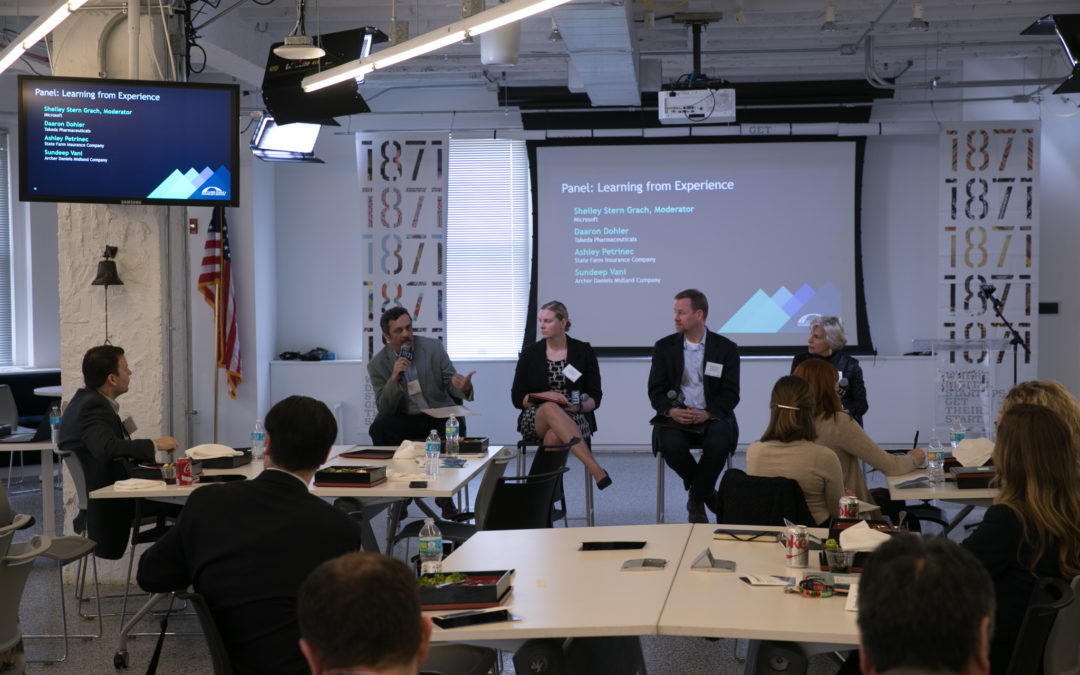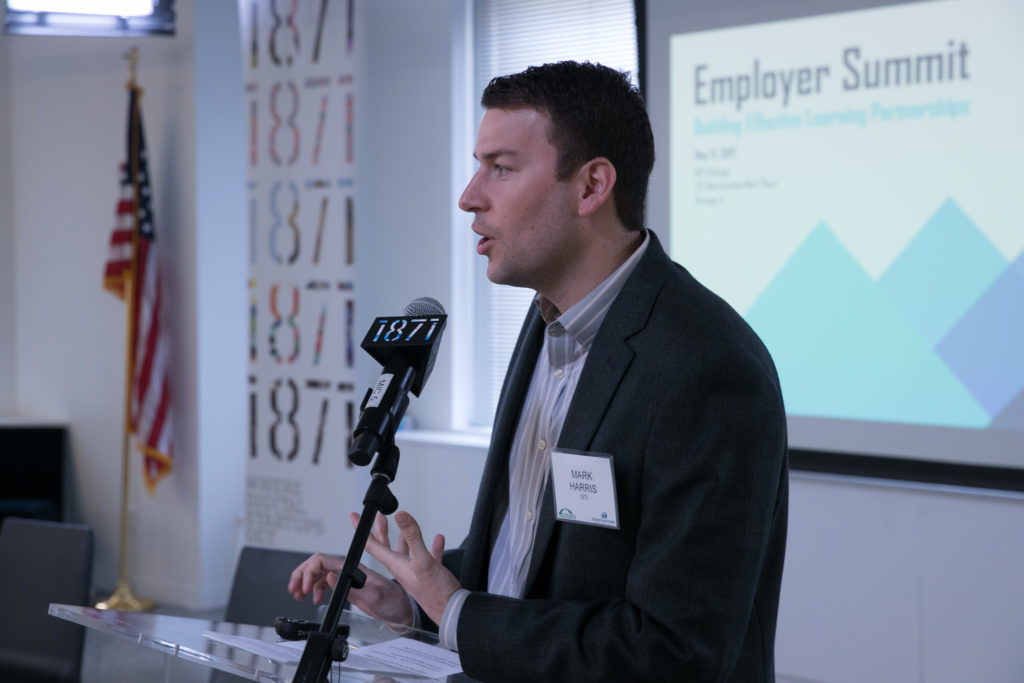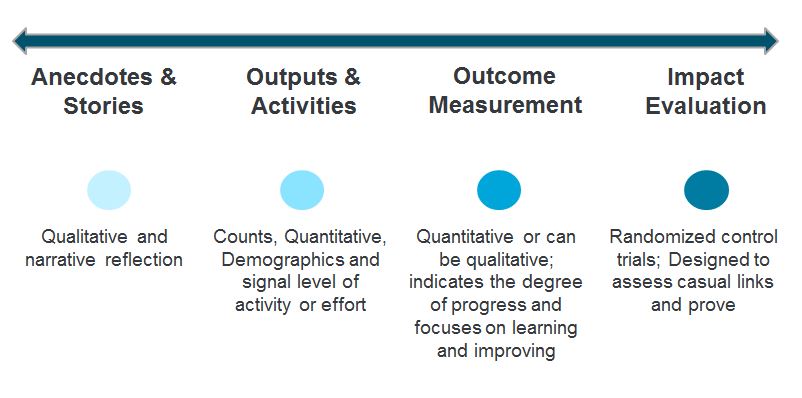by Allie Barwise, Managing Director, ISTI
On May 11th, the Illinois Science & Technology Institute, in partnership with Northern Illinois University’s Education System Center, hosted an Employer Summit to discuss building effective learning partnerships.
This employer-focused convening provided an opportunity for companies to learn about and discuss among their peers different models around impactful education programming and their partnerships with high schools. Speakers who shared their experiences and lessons learned included: Microsoft, Motorola Mobility, Motorola Solutions, State Farm, Takeda Pharmaceuticals, and others. The topics discussed ranged from problem-based learning and mentoring, to employee volunteerism, harnessing technology in the classroom, and the role of metrics in assessing impact.
In this issue of Catalyst, we explore some of the themes and takeaways that emerged from this important conversation.
Learning From Experience
This opening panel provided insights about how to implement a problem-based learning program — specifically using ISTI’s STEM Challenge as a model for discussion. Moderated by Shelley Stern Grach, Director of Civic Engagement, at Microsoft, along with panelists Daaron Dohler, Head of Business Operations, R&D Marketed Products, Takeda Pharmaceuticals; Ashley Petrinec, STEM Initiative Engagement Coordinator at State Farm; and Sundeep Vani, Technology Director at ADM, the group shared the following perspectives:
- STEM Challenges and problem-based learning more generally gives students flexibility and the ability to be creative, bringing their own ideas, interests, and perspectives.
- It’s about the journey, not the destination – going through the experimentation process, failing and trying again.
- Learning partnerships can be hard to manage on your own – it is important to partner with organizations that can bring additional resources, time, and experience.
- Mentor companies saw a range of solutions to the same STEM Challenge. For example, high school students working on medication adherence with Takeda Pharmaceuticals presented a range of ideas – from very high-tech (one team built a robot) to low-tech (another team created an awareness campaign for their school).
- Engaging employees through skills-based volunteerism and connecting them with local students is very important – provides links to future employees, particularly underrepresented groups in STEM, and an opportunity to give back.
“The Challenge is not static, because the world of technology isn’t static”
– Shelley Stern Grach, Microsoft
Harnessing Technology
Integrating innovative technology in the classroom has the capability to generate opportunity and level the playing field. In this session, Megan Wagner, Program Manager at the Motorola Mobility Foundation and Dr. Amy Pratt, Associate Director at Northwestern University’s Office of STEM Partnerships discussed how integrating technology as part of K-12 education partnerships can impact students who wouldn’t otherwise have the chance to connect outside their classroom, and how this can be done in a way that is sustainable and scalable.
Challenges
- Technology constraints, namely infrastructure in schools or corporate firewalls
- Maintaining student interest in a virtual environment can be difficult. For example, if students aren’t seeing mentors face-to-face on a daily basis, teachers hold students accountable to initiate communication. We’ve seen success in creating a regular cadence of communication – like “Mentor Mondays”.
- Maintaining commitment of mentors – schedules change
Opportunities
- Integrating technology eliminates geographic barriers
- Time & flexibility
- Scale
- Students get real-time feedback
- More easily tracked metrics
- Written communication with professionals helps to build skills for future careers
Conclusions
- Set expectations and establish a schedule with mentors and teachers up-front
- Guide students through a process – don’t tell them the answers
- Harnessing technology enables organizations to supplement
Effective Metrics
Data is a powerful tool for reporting and measuring impact. However, it can be hard to know what the right metrics are to collect, and how to use that data. In this session Kim Silver, Principal at The Silver Line and Sirisha Yadlapati, Senior Director from Motorola Solutions Foundation discussed how to assess what you want to measure, why, and how to use this data effectively.
Trends
- A change in language and landscape in the funding community when it comes to measuring social impact
- A greater desire to communicate what outcomes have come from your investment
- Using the field and research base to inform indicators
Key questions to consider
- What is the ultimate impact we are trying to achieve?
- What change would we need to see in the next 1 to 3 years to know that we are making progress toward our ultimate impact?
- What evidence or data would tell us if we are making progress? What are the leading indicators of change?
- Who are our critical stakeholders and what kind of evidence do we need to share with them to demonstrate that we are having an impact?
Conclusions
- It is important to create a common vernacular around measurement and evaluation
- Measuring social impact is a continuum of approaches
- Thinking and talking about it collectively will help all stakeholders
Thank you to those who were able to join us and participate in this important conversation. To learn more about the Illinois Science & Technology Institute – including how to become a STEM Challenge partner or use the Mentor Matching Engine, visit our website – istcoalition.org/education.
Watch
STEM Challenges are real-world projects that create opportunities for high school students to work alongside STEM professionals as mentors. Students and mentors from STEM Challenge industry partners collaborate over the course of six months to explore, create, and build innovative solutions. For more information, watch this video and visit istcoalition.org/education.
Learn more
- #STEMChallenge Student Showcase Highlights Internet of Things [Microsoft Chicago]
- Growing a Passion for Science: The first step to encouraging students to pursue STEM careers [AbbVie]
- B-N students given ‘freedom to learn’ with State Farm mentors [Bloomington Pantagraph]
- 1,200 Illinois High School Students Get Cracking on Real World Tech Problems [Chicago Inno]
- Letter to the Editor: Connecting STEM students to STEM careers [Chicago Tribune]
- Illinois high school students innovate to solve industry challenges [Video: Fox32 Chicago]
- Nonprofit brings student ideas to some of country’s largest companies [Video: NBC Chicago]
- AbbVie Teams Up With North Chicago Community High School for Illinois Science & Technology Institute’s STEM Challenge [Make It Better Media]
What we’re reading
- Study finds female students less likely to drop engineering program if female mentored [Proceedings of the National Academy of Sciences]
- The advantage Chicago has over Silicon Valley [Inc Magazine]
- Data reveals Future Founders collegiate entrepreneurs create real economic impact [Future Founders Foundation]
- Jimmy Odom joins ChicagoNext after leaving state government post [BlueSky Innovation]
- UIUC’s supercomputer has a projected $1B impact on Illinois’ economy [Chicago Inno]
- A look back at University of Illinois President Killeen’s second year in office [University of Illinois]
- Midwest startups awarded nearly $1 million at Clean Energy Trust clean-tech competition [Midwest Energy News]
- Can Chicago own innovation in Big Agriculture? [Crain’s Chicago Business]
- How immigrant entrepreneurs are changing Chicago—and the US [CNBC]
- SIU system Office of Technology Transfer ranks 76th in nation [SIUC News]
- IMSA working to get more women, minorities into science and math careers [Aurora Beacon-News]
Illinois Innovation Network Featured Resource: mySociety’s Civic Tech Report
 In new research funded and supported by Microsoft Chicago, U.K.-based mySociety, one of the world’s first civic technology organizations, analyzed five case studies of public sector-led civic technology project implementations — including Chicago’s own Large Lots project — providing a comprehensive picture the challenges and benefits that arise in the process. Full report available here.
In new research funded and supported by Microsoft Chicago, U.K.-based mySociety, one of the world’s first civic technology organizations, analyzed five case studies of public sector-led civic technology project implementations — including Chicago’s own Large Lots project — providing a comprehensive picture the challenges and benefits that arise in the process. Full report available here.



